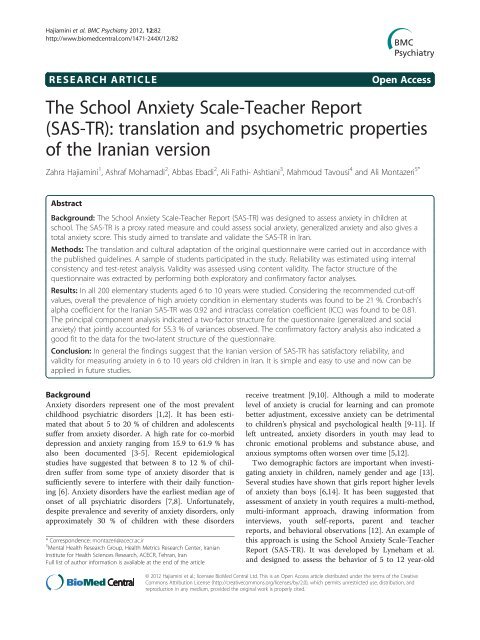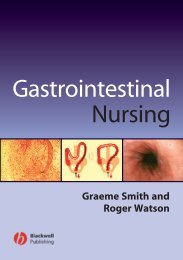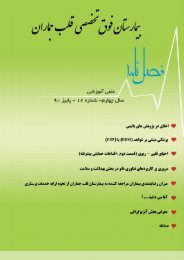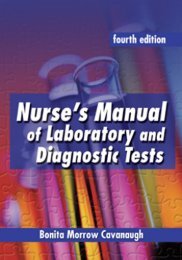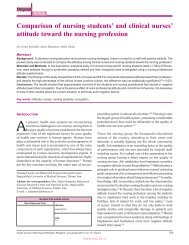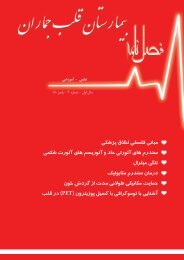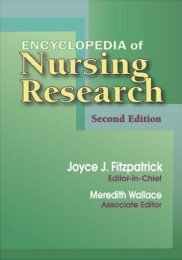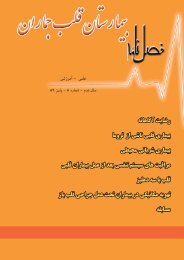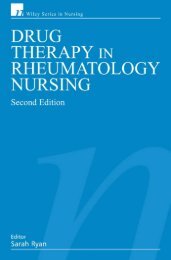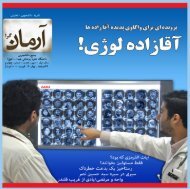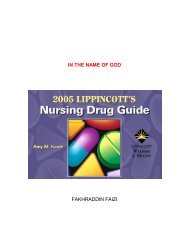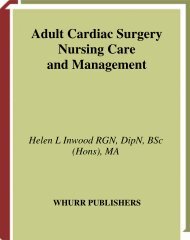The School Anxiety Scale-Teacher Report (SAS-TR): translation and ...
The School Anxiety Scale-Teacher Report (SAS-TR): translation and ...
The School Anxiety Scale-Teacher Report (SAS-TR): translation and ...
You also want an ePaper? Increase the reach of your titles
YUMPU automatically turns print PDFs into web optimized ePapers that Google loves.
Hajiamini et al. BMC Psychiatry 2012, 12:82<br />
http://www.biomedcentral.com/1471-244X/12/82<br />
RESEARCH ARTICLE<br />
Open Access<br />
<strong>The</strong> <strong>School</strong> <strong>Anxiety</strong> <strong>Scale</strong>-<strong>Teacher</strong> <strong>Report</strong><br />
(<strong>SAS</strong>-<strong>TR</strong>): <strong>translation</strong> <strong>and</strong> psychometric properties<br />
of the Iranian version<br />
Zahra Hajiamini 1 , Ashraf Mohamadi 2 , Abbas Ebadi 2 , Ali Fathi- Ashtiani 3 , Mahmoud Tavousi 4 <strong>and</strong> Ali Montazeri 5*<br />
Abstract<br />
Background: <strong>The</strong> <strong>School</strong> <strong>Anxiety</strong> <strong>Scale</strong>-<strong>Teacher</strong> <strong>Report</strong> (<strong>SAS</strong>-<strong>TR</strong>) was designed to assess anxiety in children at<br />
school. <strong>The</strong> <strong>SAS</strong>-<strong>TR</strong> is a proxy rated measure <strong>and</strong> could assess social anxiety, generalized anxiety <strong>and</strong> also gives a<br />
total anxiety score. This study aimed to translate <strong>and</strong> validate the <strong>SAS</strong>-<strong>TR</strong> in Iran.<br />
Methods: <strong>The</strong> <strong>translation</strong> <strong>and</strong> cultural adaptation of the original questionnaire were carried out in accordance with<br />
the published guidelines. A sample of students participated in the study. Reliability was estimated using internal<br />
consistency <strong>and</strong> test-retest analysis. Validity was assessed using content validity. <strong>The</strong> factor structure of the<br />
questionnaire was extracted by performing both exploratory <strong>and</strong> confirmatory factor analyses.<br />
Results: In all 200 elementary students aged 6 to 10 years were studied. Considering the recommended cut-off<br />
values, overall the prevalence of high anxiety condition in elementary students was found to be 21 %. Cronbach's<br />
alpha coefficient for the Iranian <strong>SAS</strong>-<strong>TR</strong> was 0.92 <strong>and</strong> intraclass correlation coefficient (ICC) was found to be 0.81.<br />
<strong>The</strong> principal component analysis indicated a two-factor structure for the questionnaire (generalized <strong>and</strong> social<br />
anxiety) that jointly accounted for 55.3 % of variances observed. <strong>The</strong> confirmatory factory analysis also indicated a<br />
good fit to the data for the two-latent structure of the questionnaire.<br />
Conclusion: In general the findings suggest that the Iranian version of <strong>SAS</strong>-<strong>TR</strong> has satisfactory reliability, <strong>and</strong><br />
validity for measuring anxiety in 6 to 10 years old children in Iran. It is simple <strong>and</strong> easy to use <strong>and</strong> now can be<br />
applied in future studies.<br />
Background<br />
<strong>Anxiety</strong> disorders represent one of the most prevalent<br />
childhood psychiatric disorders [1,2]. It has been estimated<br />
that about 5 to 20 % of children <strong>and</strong> adolescents<br />
suffer from anxiety disorder. A high rate for co-morbid<br />
depression <strong>and</strong> anxiety ranging from 15.9 to 61.9 % has<br />
also been documented [3-5]. Recent epidemiological<br />
studies have suggested that between 8 to 12 % of children<br />
suffer from some type of anxiety disorder that is<br />
sufficiently severe to interfere with their daily functioning<br />
[6]. <strong>Anxiety</strong> disorders have the earliest median age of<br />
onset of all psychiatric disorders [7,8]. Unfortunately,<br />
despite prevalence <strong>and</strong> severity of anxiety disorders, only<br />
approximately 30 % of children with these disorders<br />
* Correspondence: montazeri@acecr.ac.ir<br />
5 Mental Health Research Group, Health Metrics Research Center, Iranian<br />
Institute for Health Sciences Research, ACECR, Tehran, Iran<br />
Full list of author information is available at the end of the article<br />
receive treatment [9,10]. Although a mild to moderate<br />
level of anxiety is crucial for learning <strong>and</strong> can promote<br />
better adjustment, excessive anxiety can be detrimental<br />
to children’s physical <strong>and</strong> psychological health [9-11]. If<br />
left untreated, anxiety disorders in youth may lead to<br />
chronic emotional problems <strong>and</strong> substance abuse, <strong>and</strong><br />
anxious symptoms often worsen over time [5,12].<br />
Two demographic factors are important when investigating<br />
anxiety in children, namely gender <strong>and</strong> age [13].<br />
Several studies have shown that girls report higher levels<br />
of anxiety than boys [6,14]. It has been suggested that<br />
assessment of anxiety in youth requires a multi-method,<br />
multi-informant approach, drawing information from<br />
interviews, youth self-reports, parent <strong>and</strong> teacher<br />
reports, <strong>and</strong> behavioral observations [12]. An example of<br />
this approach is using the <strong>School</strong> <strong>Anxiety</strong> <strong>Scale</strong>-<strong>Teacher</strong><br />
<strong>Report</strong> (<strong>SAS</strong>-<strong>TR</strong>). It was developed by Lyneham et al.<br />
<strong>and</strong> designed to assess the behavior of 5 to 12 year-old<br />
© 2012 Hajiamini et al.; licensee BioMed Central Ltd. This is an Open Access article distributed under the terms of the Creative<br />
Commons Attribution License (http://creativecommons.org/licenses/by/2.0), which permits unrestricted use, distribution, <strong>and</strong><br />
reproduction in any medium, provided the original work is properly cited.
Hajiamini et al. BMC Psychiatry 2012, 12:82 Page 2 of 7<br />
http://www.biomedcentral.com/1471-244X/12/82<br />
children at school, targeting the behaviors <strong>and</strong> feelings<br />
distinctive to the experience of anxiety. Psychometric<br />
evaluation of the original <strong>SAS</strong>-<strong>TR</strong> was conducted on 240<br />
community <strong>and</strong> 140 anxiety disorder children (n = 380).<br />
Factor analysis of the <strong>SAS</strong>-<strong>TR</strong> identified two subscales<br />
reflecting social <strong>and</strong> generalized anxiety that jointly<br />
accounted for 58 % of the variance observed. Also the<br />
<strong>SAS</strong>-<strong>TR</strong> was found to have an acceptable internal<br />
consistency (Crobnbach’s alpha coefficient for the scale<br />
was 0.93 <strong>and</strong> for its subscales social <strong>and</strong> generalized anxiety<br />
it was 0.92 <strong>and</strong> 0.90, respectively). In order to compare<br />
the <strong>SAS</strong>-<strong>TR</strong> scores across gender <strong>and</strong> age groups,<br />
the results obtained from univriate analysis of variance<br />
indicted no significant evidence for interaction or main<br />
effects for age <strong>and</strong> gender. In addition clinical application<br />
of the <strong>SAS</strong>-<strong>TR</strong> was evident where the scale discriminated<br />
well between the community <strong>and</strong> clinical<br />
groups [15]. Since the <strong>SAS</strong>-<strong>TR</strong> was not available in Iran,<br />
the present study aimed to translate <strong>and</strong> culturally adapt<br />
the <strong>SAS</strong>-<strong>TR</strong> in Iran. <strong>The</strong> second objective of the study<br />
was to investigate the psychometric properties of the<br />
Iranian version of <strong>SAS</strong>-<strong>TR</strong>.<br />
Methods<br />
<strong>The</strong> questionnaire <strong>and</strong> scoring<br />
As mentioned earlier the <strong>School</strong> <strong>Anxiety</strong> <strong>Scale</strong>-<strong>Teacher</strong><br />
<strong>Report</strong> (<strong>SAS</strong>-<strong>TR</strong>) contains two subscales: social anxiety<br />
<strong>and</strong> generalized anxiety. Social anxiety disorder, also<br />
known as social phobia (SP), is described as a fear of humiliation<br />
<strong>and</strong>/or embarrassment in social situations,<br />
which may lead to significant avoidance of <strong>and</strong> distress<br />
in such situations. Social anxiety in children may be<br />
expressed by crying, temper tantrums, fidgeting, somatic<br />
complaints, <strong>and</strong> withdrawal from social situations (e.g.,<br />
school refusal) [16-18]. Generalized anxiety disorder,<br />
formerly termed overanxious disorder, refers to excessive<br />
anxiety <strong>and</strong> worry, accompanied by symptoms of motor<br />
tension <strong>and</strong> vigilance [16,17]. <strong>The</strong>se two subscales include<br />
16 items (7 items on social anxiety <strong>and</strong> 9 items on<br />
generalized anxiety) <strong>and</strong> it takes approximately 5 minutes<br />
to complete the questionnaire. Each item is rated<br />
by a teacher to describe how the child had been over the<br />
last 6 months on a 4-point Likert scale ranging from 0<br />
to 3 (never = 0, sometimes = 1, often = 2 <strong>and</strong> always = 3)<br />
[15]. Possible scores for the social anxiety range from 0<br />
to 21, for the generalized anxiety from 0 to 27, <strong>and</strong> for<br />
the total anxiety from 0 to 48. Scores of 8 <strong>and</strong> more on<br />
the social anxiety, 10 or more on the generalized anxiety,<br />
<strong>and</strong> 17 or more on the total anxiety is considered to represent<br />
high anxious condition.<br />
Translation<br />
Permission was asked from the main author (Lyneham)<br />
to translate <strong>and</strong> validate the <strong>SAS</strong>-<strong>TR</strong> in Iran. Forwardbackward<br />
procedure was applied to translate the <strong>SAS</strong>-<br />
<strong>TR</strong> from English into Persian (the Iranian language).<br />
Two independent professional translators produced two<br />
forward <strong>translation</strong>s of the <strong>SAS</strong>-<strong>TR</strong> in Persian. One<br />
translator was aware of the project <strong>and</strong> the other translator<br />
was not. Both translators were instructed to aim for<br />
conceptual rather than literal <strong>translation</strong> [19]. Together<br />
with one of the authors, the translators compared their<br />
<strong>translation</strong>s <strong>and</strong> produced a single provisional version of<br />
the questionnaire. Totally blind to the original version,<br />
two other professional translators translated the<br />
provisional Persian questionnaire back into the English<br />
language [20]. Finally, an expert committee consisting of<br />
the translators, the researchers, three psychologists, <strong>and</strong><br />
one outcome methodologist reviewed the <strong>translation</strong><br />
<strong>and</strong> cultural adaptation processes. <strong>The</strong> authors evaluated<br />
all findings from this phase of the adaptation process<br />
<strong>and</strong> then the final Iranian version of <strong>SAS</strong>-<strong>TR</strong> was developed<br />
<strong>and</strong> used in this study for further psychometric<br />
testing [see Additional file 1].<br />
Procedure<br />
First a separate list of elementary schools (for girls <strong>and</strong><br />
boys) were identified in Abhar, Iran. <strong>The</strong>n using the<br />
snowbal approach, four schools for girls <strong>and</strong> four shcools<br />
for boys were selected. After permission from authorities<br />
(Misinstry of Education-Abhar Office), the head teachers<br />
were contacted in order to coordinate the data collection<br />
processes. Prior to the data collection a letter was sent<br />
out to all parents explaining the research project <strong>and</strong> indicating<br />
that the during coming days their child might be<br />
selected to be evaluated by his or her teacher for indication<br />
of any possible anxiety using the attached questionnaire.<br />
<strong>The</strong> Iranian version of <strong>SAS</strong>-<strong>TR</strong> was enclosed <strong>and</strong><br />
they were asked to return the letter by check marking<br />
their agreement or disagreement. <strong>The</strong> head teachers<br />
signed the letter <strong>and</strong> parents were asked to return their<br />
reply by a week at latest. <strong>The</strong> confidentiality clearly was<br />
acknowledged in the letter <strong>and</strong> we indicated that the data<br />
would only be used for the research purposes. <strong>The</strong>n, in<br />
an agreed date teachers were asked to complete a paper<br />
<strong>and</strong> pencile version of the final draft of the Iranian version<br />
of <strong>SAS</strong>-<strong>TR</strong> for each student while one of us (AMo)<br />
was present in the agreed school for any possible help or<br />
inquiries. <strong>Teacher</strong>s were asked to r<strong>and</strong>omly select five<br />
students from the list of students in their class while<br />
checking for parental consent. For the purpose of the<br />
test-retest analysis four teachers (two male <strong>and</strong> two female<br />
teachers) were asked to complete the questionnaire<br />
twice for the same students with a four-week intervals.<br />
Participants<br />
In all, 200 elementary students aged 6 to 10 years (mean<br />
age = 7.97, SD = 1.41) were included in the study.
Hajiamini et al. BMC Psychiatry 2012, 12:82 Page 3 of 7<br />
http://www.biomedcentral.com/1471-244X/12/82<br />
Table 1 <strong>The</strong> <strong>SAS</strong>-<strong>TR</strong> score by age <strong>and</strong> gender*<br />
Social<br />
anxiety<br />
Generalized<br />
anxiety<br />
Total<br />
Mean (SD) Mean (SD) Mean (SD)<br />
Age (year)<br />
Preschool (6 years old, 7.4 (6.2) 6.3 (5.4) 13.7 (11.1)<br />
n = 46)<br />
<strong>School</strong> age<br />
5.3 (5.0) 4.7 (4.4) 10.1 (8.9)<br />
(7–10 years old, n = 154)<br />
P** 0.03 0.18 0.05<br />
Gender<br />
Female (n = 144) 5.9 (5.9) 5.4 (4.8) 11.3 (10.2)<br />
Male (n = 56) 5.5 (3.8) 4.1 (4.1) 9.6 (7.3)<br />
P* 0.45 0.05 0.74<br />
* Higher scores represent greater distress.<br />
** Derived from Mann–Whitney U test.<br />
Elementary students divided into two groups: preschool<br />
(6 years old, n = 46) <strong>and</strong> school aged students (7–10 years<br />
old, n = 154). Seventy-two percent of elementary students<br />
were female (n = 144), <strong>and</strong> the remaining 28 %<br />
were male (n =56). Overall 11 male teachers <strong>and</strong> 29 female<br />
teachers helped us to collect the data. As agreed<br />
each teacher was responsible for completing the questionnaire<br />
for five students. However, one male teacher<br />
completed 6 questionnaires <strong>and</strong> one female teacher<br />
completed 4 questionnaires.<br />
Statistical analysis<br />
In addition to descriptive statistics several analyses were<br />
carried out in order to assess the psychometric properties<br />
of the Iranian version of <strong>SAS</strong>-<strong>TR</strong>.<br />
1. Reliability: Internal consistency of the scale was<br />
examined using Cronbach’s alpha coefficient. Values<br />
equal to or greater than 0.70 were considered satisfactory<br />
[21]. In addition the test-retest reliability of the<br />
scale was estimated by intraclass correlation coefficient<br />
(ICC). <strong>The</strong> ICC is an estimate of the fraction of the total<br />
measurement variability due to variation among individuals<br />
[22]. <strong>The</strong> following categories were used to interpret<br />
the agreement levels: 0.0-0.2 as slight, 0.21-0.40 as<br />
fair, 0.41-0.60 as moderate, 0.61-0.80 as substantial, <strong>and</strong><br />
0.81-1 as almost perfect [23].<br />
2. Validity: It was assessed using content validity. Content<br />
validity is the degree to which a sample of items<br />
taken together, constitute an adequate operational definition<br />
of a construct [24]. For content validity the questionnaire<br />
was provided to 10 faculty <strong>and</strong> psychiatric<br />
experts <strong>and</strong> were asked to answer a 4-point Liker scale<br />
in order to assess that the questions measured what they<br />
were intended to measure (relevancy), <strong>and</strong> that the items<br />
were clear enough to be understood without difficulty<br />
(clarity), <strong>and</strong> finally that the questions were simple<br />
enough to be rated (simplicity). <strong>The</strong>n, the Content Validity<br />
Index (CVI) was calculated for the scale. Polite <strong>and</strong><br />
Beck recommended 0.80 for the acceptable lower limit<br />
for the CVI value [25].<br />
3. Factor analysis: <strong>The</strong> factor structure of the questionnaire<br />
was extracted by performing both exploratory<br />
(EFA) <strong>and</strong> confirmatory factor analyses (CFA). Exploratory<br />
factor analysis was performed using the principal<br />
component analysis with varimax solution. This is a rotation<br />
method that minimizes the number of variables<br />
that have high loadings on each factor. It simplifies the<br />
interpretation of the factors. It was hypothesized that a<br />
two-factor solution would be obtained with eigenvalues<br />
greater than 1. In order to evaluate sampling adequacy<br />
for performing a satisfactory factor analysis, Kaiser-<br />
Meyer-Olkin Measure of Sampling Adequacy (KMO)<br />
<strong>and</strong> Bartlett’s tests also were calculated. Confirmatory<br />
factor analysis was performed while a two-factor model<br />
(generalized anxiety <strong>and</strong> social anxiety) was specified.<br />
Several goodness-of- fit indicators including: goodness<br />
of fit index (GFI), adjusted goodness of fit index (AGFI),<br />
the root mean square error of approximation (RMSEA),<br />
normed fit index (NFI), <strong>and</strong> comparative fit index (CFI)<br />
Table 2 Prevalence of anxiety levels in elementary students according to the cut-off values by age <strong>and</strong> gender<br />
Social anxiety Generalized anxiety Total score<br />
Normal No.<br />
(%)<br />
High No.<br />
(%)<br />
Normal No.<br />
(%)<br />
High No.<br />
(%)<br />
Normal No.<br />
(%)<br />
High No.<br />
(%)<br />
Age<br />
Preschool age (6 years old, n = 46) 30 (19.6) 16 (34.0) 31 (19.4) 15 (37.5) 31 (19.6) 15 (35.7)<br />
<strong>School</strong> age (7–10 years old, n = 154) 123 (80.4) 31 (66.0) 129 (80.6) 25 (62.5) 127 (80.4) 27 (64.3)<br />
P (df, χ 2 ) 0.04 (1, 4.23) 0.01 (1, 5.93) 0.03 (1, 4.85)<br />
Gender<br />
Female (n = 144) 107 (69.9) 37 (78.7) 112 (70.0) 32 (80.0) 110 (69.6) 34 (81.0)<br />
Male (n = 56) 46 (30.1) 10 (21.3) 48 (30.0) 8 (20.0) 48 (30.4) 8 (19.0)<br />
P (df, χ 2 ) 0.24 (1, 1.37) 0.21 (1, 1.58) 0.14 (1, 2.11)<br />
All (n = 200) 153 (76.5) 47 (23.5) 160 (80.0) 40 (20.0) 158 (79.0) 42 (21.0)
Hajiamini et al. BMC Psychiatry 2012, 12:82 Page 4 of 7<br />
http://www.biomedcentral.com/1471-244X/12/82<br />
Table 3 <strong>The</strong> descriptive findings (n = 200)<br />
Mean (SD) Observed range<br />
(possible range)<br />
Cronbach’s<br />
alpha<br />
coefficient<br />
Social anxiety 5.1 (4.7) 0-19 (0–21) 0.85 0.92<br />
Generalized anxiety 5.8 (5.4) 0-23 (0–27) 0.88 0.70<br />
<strong>The</strong> total 10.9 (9.5) 0-42 (0–48) 0.92 0.81<br />
were selected for reporting the analysis outcomes. <strong>The</strong><br />
GFI <strong>and</strong> AGFI are chi-square based calculations independent<br />
of degrees of freedom. <strong>The</strong> recommended cutoff<br />
values for acceptable values are ≥ 0.90. <strong>The</strong> RMSEA<br />
tests the fit of the model to the covariance matrix. As a<br />
guideline, values of < 0.05 indicate a close fit <strong>and</strong> values<br />
below 0.11 are an acceptable fit. <strong>The</strong> NFI <strong>and</strong> CFI values<br />
range from 0 to 1 with a value of 0.90 <strong>and</strong> greater being<br />
acceptable fit to the data [26,27].<br />
Ethics<br />
<strong>The</strong> study received approval from the Ethics Committee<br />
of Bagiyatallah University of Medical Sciences <strong>and</strong> authorities.<br />
In addition, as indicated parental consent was<br />
obtained.<br />
Results<br />
Age <strong>and</strong> sex differences<br />
<strong>The</strong> mean <strong>SAS</strong>-<strong>TR</strong> score by age <strong>and</strong> gender are shown<br />
in Table 1. <strong>The</strong>re were significant age differences for the<br />
social (P = 0.03) <strong>and</strong> the total anxiety scores (P = 0.05)<br />
ICC<br />
but not for the generalized anxiety (P = 0.18). No significant<br />
gender differences were observed for the social<br />
(P = 0.45) <strong>and</strong> the total anxiety score (P = 0.74). However,<br />
the difference for the generalized anxiety score was just<br />
significant (P = 0.05).<br />
Considering the recommended cut-off values, overall<br />
the prevalence of high anxiety condition was found to be<br />
21 %. <strong>The</strong> results are shown in Table 2. <strong>The</strong>re were significant<br />
differences between the two age groups <strong>and</strong> the<br />
different levels of social (P = 0.04), generalized (P =0.01),<br />
<strong>and</strong> total anxiety (P = 0.03). However, there were no significant<br />
differences between gender <strong>and</strong> the different<br />
levels of social (P = 0.24), generalized (P = 0.21), <strong>and</strong> total<br />
anxiety (P = 0.14).<br />
Reliability<br />
<strong>The</strong> descriptive findings for the social, generalized, <strong>and</strong><br />
total anxiety scores for all students are presented in<br />
Table 3. <strong>The</strong> internal consistency (to examine reliability)<br />
as measured by Cronbach’s alpha coefficient found to be<br />
satisfactory. As shown in the Table 3, all alpha coefficients<br />
exceeded the recommended value of 0.70, lending<br />
support to the scale’s reliability in general <strong>and</strong> for its subscales<br />
in particular. Intraclass correlation coefficients also<br />
were found to be acceptable, ranging from 0.70 to 0.92.<br />
Content validity<br />
<strong>The</strong> content validity index (CVI) for the scale was calculated<br />
<strong>and</strong> it was found to be 0.90 indicating a satisfactory<br />
Table 4 <strong>The</strong> results obtained from exploratory factor analysis of the Iranian version of <strong>SAS</strong>-<strong>TR</strong><br />
Factor1<br />
(Generalized anxiety)<br />
1. This child is afraid of asking questions in class. 0.284 0.647<br />
2. This child speaks only when someone asks a question them. 0.183 0.707<br />
3. This student worries about what others think of him/her. 0.512 0.465<br />
4. This child does not volunteer answers or comments during class 0.078 0.715<br />
5. This child is afraid of making mistakes. 0.549 0.525<br />
6. This child hates being the center of attention. 0.406 0.620<br />
7. This child hesitates in starting tasks whether they understood the task before starting. 0.603 0.552<br />
8. This child worries about things. 0.527 0.485<br />
9. This child worries that (s)he will do badly at school. 0.601 0.435<br />
10. This child worries that something bad may happen to him/her. 0.710 0.297<br />
11. This child seems very shy. 0.456 0.553<br />
12. This child complains of headache, stomach aches or feeling sick. 0.600 0.238<br />
13. This child feels afraid when (s)he has to talk in front of the class. 0.499 0.614<br />
14. This child hesitates to speak when in group situations. 0.563 0.617<br />
15. When this child has a problem, (s)he feels shaky. 0.764 0.234<br />
16. This child appears nervous when approached by other children or adults. 0.667 0.208<br />
Eigenvalues 7.4 1.2<br />
Variance observed (%) 47.6 7.7<br />
Factor2<br />
(Social anxiety)
Hajiamini et al. BMC Psychiatry 2012, 12:82 Page 5 of 7<br />
http://www.biomedcentral.com/1471-244X/12/82<br />
result. Ten experts rated almost all items as relevant,<br />
clear <strong>and</strong> simple.<br />
GFI = 0.90, AGFI = 0.82, RMSEA = 0.08, NFI = 0.95, <strong>and</strong><br />
CFI = 0.96.<br />
Factor analysis<br />
Exploratory factor analysis (EFA) was used to determine<br />
the underlying factor structure of the set of items. <strong>The</strong><br />
calculated KMO was 0.92 <strong>and</strong> the Bartlett's test of<br />
sphericity was significant (P < 0.0001) showing that the<br />
sample size was adequate for the analysis. Based on<br />
eigenvalues higher than 1 <strong>and</strong> loading level of 0.4 or<br />
above, a two-factor solution emerged. <strong>The</strong> two-factor solution<br />
jointly explained 55.3 % of the total variance<br />
observed. <strong>The</strong> results are shown in Table 4.<br />
<strong>The</strong> results for confirmatory factor analysis are shown<br />
in Figure 1. <strong>The</strong> two-factor model, that is generalized<br />
<strong>and</strong> social anxiety, was specified <strong>and</strong> tested. <strong>The</strong> results<br />
provided a good fit to the data lending support to the original<br />
hypothesized structure of the questionnaire with<br />
Discussion<br />
<strong>The</strong> main purpose of this study was to translate <strong>and</strong><br />
examine reliability <strong>and</strong> validity of the <strong>SAS</strong>-<strong>TR</strong> questionnaire<br />
in Iran. In general, the results showed that the Iranian<br />
version of <strong>SAS</strong>-<strong>TR</strong> had reasonably satisfactory internal<br />
consistency, test-retest reliability, content validity <strong>and</strong> factor<br />
structure.<br />
<strong>The</strong> overall prevalence of total anxiety in elementary<br />
students as reported by teachers was found to be 21 %.<br />
In fact this indicates that application of the clinical cutoffs<br />
designed to identify the top 20 % of anxious children<br />
in the Australian data have successfully identified the<br />
same proportion of anxious children in the Iranian sample<br />
[15]. Also the result was very similar to the findings<br />
by other investigators. Egger <strong>and</strong> Angold [28] found that<br />
0.63<br />
q1<br />
0.63<br />
q2<br />
0.61<br />
0.82<br />
q4<br />
0.61<br />
0.51<br />
q6<br />
0.42<br />
0.70<br />
0.70<br />
Social<br />
anxiety<br />
1.00<br />
0.51<br />
q11<br />
0.81<br />
0.85<br />
0.35<br />
q13<br />
0.27<br />
q14<br />
0.55<br />
q3<br />
0.92<br />
0.46<br />
q5<br />
0.34<br />
q7<br />
0.67<br />
0.73<br />
0.49<br />
0.46<br />
q8<br />
q9<br />
0.81<br />
0.72<br />
0.74<br />
0.71<br />
Generalized<br />
anxiety<br />
1.00<br />
0.49<br />
q10<br />
0.27<br />
0.71<br />
0.93<br />
q12<br />
0.62<br />
0.49<br />
q15<br />
0.61<br />
q16<br />
Figure 1 A two-factor model for the Iranian version of <strong>SAS</strong>-<strong>TR</strong> obtained from confirmatory factor analysis.
Hajiamini et al. BMC Psychiatry 2012, 12:82 Page 6 of 7<br />
http://www.biomedcentral.com/1471-244X/12/82<br />
the prevalence of any psychiatric disorders among 2 to<br />
5 years old preschool children ranged from 16 % to 26 %<br />
<strong>and</strong> Birmaher et al. [29] reported that the prevalence of<br />
anxiety in preschool children was 22 %.<br />
<strong>The</strong> current study did not show significant differences<br />
for the total anxiety (P = 0.45) <strong>and</strong> social anxiety<br />
(P = 0.74) among male <strong>and</strong> female students. <strong>The</strong>se findings<br />
were similar to the original validation study that<br />
carried out by Lyneham et al. [15], but as indicated by<br />
them the findings were different from studies that<br />
reported higher levels of anxiety among girls than boys<br />
[7,11,13,14]. One explanation for such findings by Lyneham<br />
<strong>and</strong> us might be due to the fact that we both used a<br />
proxy measure of anxiety while others used self-rated<br />
questionnaires. However, boys scored lower indicating<br />
less anxiety than girls <strong>and</strong> that we found only a marginal<br />
significant difference for generalized anxiety between<br />
boys <strong>and</strong> girls (P = 0.05).<br />
<strong>The</strong> findings also indicated that there were significant<br />
differences between age <strong>and</strong> the total anxiety <strong>and</strong> social<br />
anxiety scores but not for generalized anxiety where preschool<br />
children showed higher anxiety. Using the same<br />
instrument Lyneham et al. found no significant age differences<br />
for the total <strong>SAS</strong>-<strong>TR</strong> score or for the scores on<br />
the either subscales [15]. To explain our findings as suggested,<br />
it is argued when children reach a certain level of<br />
cognitive development, their ability to perceive situations<br />
as potentially dangerous increases. With increasing age,<br />
however, the child gets a better underst<strong>and</strong>ing of these<br />
situations <strong>and</strong> learns to control them, which reduces<br />
anxiety [13]. In addition, it should be noted that the<br />
<strong>SAS</strong>-<strong>TR</strong> was designed for school age children <strong>and</strong> not<br />
for preschoolers. Perhaps differences in educational systems<br />
may also account for differences in findings. Furthermore,<br />
as pointed out in the literature it is generally<br />
assumed that anxiety decreases in non-clinical children<br />
as they become older [14]. In general there is minimal<br />
information about the prevalence of anxiety disorders in<br />
preschoolers [30].<br />
Exploratory factor analysis indicated a two-factor solution<br />
for the scale that jointly explained 55.3 % of the<br />
variance observed. <strong>The</strong> finding was very similar to the<br />
original validation study where a two-factor solution<br />
accounting for 58.5 % of the variance was reported (factor<br />
1: 49.6 % <strong>and</strong> factor 2: 8.9 %) [15]. Interestingly the<br />
results obtained from the confirmatory factor analysis<br />
also indicated that the two-factor model fitted to the<br />
data very well <strong>and</strong> ensured the original conceptual<br />
model of the instrument.<br />
This study had several limitations. <strong>The</strong> most important<br />
one relates to the fact that not many boys included in<br />
the study. Secondly we did not use clinical samples or<br />
clinical measures to assess further psychometric properties<br />
of the scale such as known groups comparison.<br />
Thirdly, construct, convergent <strong>and</strong> divergent validity<br />
were not examined. Future studies might focus on these<br />
aspects of the validation process.<br />
Conclusion<br />
This study showed satisfactory cultural adaptation, reliability,<br />
content validity <strong>and</strong> factor structure for the Iranian<br />
version of <strong>SAS</strong>-<strong>TR</strong>. However, considering the study<br />
limitations, the findings should not be generalized. In<br />
general this instrument will be a valuable teacher<br />
reported measure for the evaluation of school anxiety<br />
(social <strong>and</strong> generalized) among elementary students in<br />
Iran <strong>and</strong> other Persian-speaking countries.<br />
Additional file<br />
Additional file 1: Iranian (Persian) version of the <strong>SAS</strong>-<strong>TR</strong>. <strong>The</strong> file<br />
contains the Iranian version of the <strong>School</strong> <strong>Anxiety</strong> <strong>Scale</strong>-<strong>Teacher</strong> <strong>Report</strong>.<br />
Competing interests<br />
<strong>The</strong> authors declare that they have no competing interests.<br />
Author details<br />
1 Behavioral Sciences Research Center <strong>and</strong> <strong>School</strong> of Nursing, Baqiyatallah<br />
University of Medical Sciences, Tehran, Iran. 2 <strong>School</strong> of Nursing, Bagiyatallah<br />
University of Medical Sciences, Tehran, Iran. 3 Behavioral Sciences Research<br />
Center, Bagiyatallah University of Medical Sciences, Tehran, Iran. 4 Health<br />
Education <strong>and</strong> Promotion Research Group, Health Metrics Research Center,<br />
Iranian Institute for Health Sciences Research, ACECR, Tehran, Iran. 5 Mental<br />
Health Research Group, Health Metrics Research Center, Iranian Institute for<br />
Health Sciences Research, ACECR, Tehran, Iran.<br />
Authors’ contribution<br />
AMo was the main investigator <strong>and</strong> collected the data <strong>and</strong> wrote the first<br />
draft. ZH supervised the study <strong>and</strong> contributed to the analysis <strong>and</strong> writing.<br />
AE <strong>and</strong> AFA were the study advisors. MT performed confirmatory factor<br />
analysis <strong>and</strong> provided the figure. AM reanalyzed the data, critically evaluated<br />
the manuscript <strong>and</strong> provided the final manuscript. All authors read <strong>and</strong><br />
approved the final manuscript.<br />
Received: 2 February 2011 Accepted: 18 July 2012<br />
Published: 18 July 2012<br />
References<br />
1. Cartwright-Hatton S, McNicol K, Doubleday E: <strong>Anxiety</strong> in a neglected<br />
population: prevalence of anxiety disorders in pre-adolescent children.<br />
Clin Psychol Review 2006, 27:817–833.<br />
2. Waters AM, Craske MG, Bergman RL, Naliboff BD, Negoro H, Ornitz EM:<br />
Developmental changes in startle reactivity in school-age children at risk<br />
for <strong>and</strong> with actual anxiety disorder. Int J Psychophysiol 2008, 70:158–164.<br />
3. Essau CA: Frequency, comorbidity <strong>and</strong> psychosocial impairment of<br />
anxiety disorders in German adolescents. J <strong>Anxiety</strong> Disord 2000,<br />
14:263–279.<br />
4. Linyan S, Kai W, Fang F, Yi S, Xueping G: Reliability <strong>and</strong> validity of the<br />
screen for child anxiety related emotional disorders (SCARED) in Chinese<br />
children. J <strong>Anxiety</strong> Disord 2008, 22:612–621.<br />
5. Spence SH, Barrett PM, Turner CM: Psychometric properties of the Spence<br />
Children’s <strong>Anxiety</strong> <strong>Scale</strong> with young adolescents. <strong>Anxiety</strong> Disord 2003,<br />
17:605–625.<br />
6. Essau CA, Sakano Y, Ishikawa S, Sasagawa S: <strong>Anxiety</strong> symptoms in<br />
Japanese <strong>and</strong> in German children. Behav Res <strong>The</strong>r 2004, 42:601–612.<br />
7. Broeren S, Muris P: Psychometric evaluation of two new parent-rating<br />
scales for measuring anxiety symptoms in young Dutch children.<br />
J <strong>Anxiety</strong> Disord 2008, 22:949–958.
Hajiamini et al. BMC Psychiatry 2012, 12:82 Page 7 of 7<br />
http://www.biomedcentral.com/1471-244X/12/82<br />
8. Kessler RC, Berglund P, Demler O, Jin R, Merikangas KR, Walters EE: Lifetime<br />
prevalence <strong>and</strong> age-of-onset distributions of DSM-IV disorders in the<br />
National Comorbidity Survey Replication. Archives of General Psychiatry<br />
2005, 62:593–602.<br />
9. Whiteside SP, Brown AM: Exploring the utility of the Spence Children’s<br />
<strong>Anxiety</strong> <strong>Scale</strong>s parent- <strong>and</strong> child-report forms in a North American<br />
sample. J <strong>Anxiety</strong> Disord 2008, 22:1440–1446.<br />
10. Muris P: Normal <strong>and</strong> abnormal fear <strong>and</strong> anxiety in children <strong>and</strong> adolescents.<br />
Oxford: Elsevier; 2007.<br />
11. William Li Ho C, Lopez V: Development <strong>and</strong> validation of a short form of<br />
the Chinese version of the State <strong>Anxiety</strong> <strong>Scale</strong> for Children. Int J Nurs<br />
Studies 2007, 44:566–573.<br />
12. Kendall PC, Puliafico AC, Barmish AJ, Choudhury MS, Henin A, Treadwell KS:<br />
Assessing anxiety with the Child Behavior Checklist <strong>and</strong> the <strong>Teacher</strong><br />
<strong>Report</strong> Form. J <strong>Anxiety</strong> Disord 2007, 21:1004–1015.<br />
13. Bodden D: HM, Bogels SM, Muris P: <strong>The</strong> diagnostic utility of the screen<br />
for child anxiety related emotional disorders-71 (SCARED-71). Behav Res<br />
<strong>The</strong>r 2009, 47:418–425.<br />
14. Castellanos D, Hunter T: <strong>Anxiety</strong> disorders in children <strong>and</strong> adolescents.<br />
S Med J 1999, 92:946–953.<br />
15. Lyneham HJ, Street AK, Abbott MJ, Rapee RM: Psychometric properties of<br />
the school anxiety scale- teacher report (<strong>SAS</strong> –<strong>TR</strong>). J <strong>Anxiety</strong> Disord 2008,<br />
22:292–300.<br />
16. Muris P, Schmidt H, Merckelbach H: Correlations among two self-report<br />
questionnaires for measuring DSM-defined anxiety disorder symptoms<br />
in children: the Screen for Child <strong>Anxiety</strong> Related Emotional Disorders<br />
<strong>and</strong> the Spence Children's <strong>Anxiety</strong> <strong>Scale</strong>. Pers Individ Differences 2000,<br />
28:333–346.<br />
17. Muris P, Merckelbach H, Ollendick T, King N, Bogie N: Three traditional <strong>and</strong><br />
three new childhood anxiety questionnaires: their reliability <strong>and</strong> validity<br />
in a normal adolescent sample. Behav Res <strong>The</strong>r 2002, 40:753–772.<br />
18. Kuusikko S, Pollock-Wurman R, Ebeling H, Hurtig T, Joskitt L, Mattila ML,<br />
Jussila K, Moilanen I: Psychometric evaluation of social phobia <strong>and</strong><br />
anxiety inventory for children (SPAI-C) <strong>and</strong> social anxiety scale for<br />
children-revised (<strong>SAS</strong>C-R). Eur Child Adolesc Psychiatry 2009, 18:116–124.<br />
19. WHO: Process of <strong>translation</strong> <strong>and</strong> adaptation of instruments. http://www.who.<br />
int/substance_abuse/research_tools/<strong>translation</strong>/en/.<br />
20. Bulliger M, Alonso J, Apolone G: Translating health status questionnaire<br />
<strong>and</strong> evaluating their quality: the IQOLA Project approach. J Clin Epidemol<br />
1998, 9:13–23.<br />
21. Nunnally JC, Bernstein IH: Psychometric theory. NewYork:McGraw-HillInc;1994.<br />
22. Anastasia A: Validity: Basic Concepts, InPsychological Testing. 6th edition.<br />
New York: Macmillan Publishing Company; 1990:139–157.<br />
23. L<strong>and</strong>is JR, Koch GG: <strong>The</strong> measurement of observer agreement for<br />
categorical data. Biometrics 1977, 33:159–174.<br />
24. Polit DF, Beck CT: <strong>The</strong> content validity index: are you sure you know<br />
what’s being reported? Critique <strong>and</strong> recommendations. Res in Nurs &<br />
Health 2006, 29:489–497.<br />
25. Polit DF, Beck CT: Nursing research: principles <strong>and</strong> methods. 46th edition.<br />
Philadelphia: Lippincott; 2004:416–445.<br />
26. Marsh HW, Hau K, Wen Z: In search of golden rules: comment on<br />
hypothesis testing approaches to setting cut-off values for fit indexes<br />
<strong>and</strong> dangers in over generalizing Hu <strong>and</strong> Bentler’s findings. Structural<br />
Equation Model 2004, 11:320–341.<br />
27. Byrne BM: Structural Equation Modelling. Mahwah, NJ: Lawrence Erlbaum<br />
Associates Publishers; 1998.<br />
28. Egger HL, Angold A: Common emotional <strong>and</strong> behavioral disorders in<br />
preschool children: Presentation, nosology, <strong>and</strong> epidemiology. J Child<br />
Psychol Psychiatry 2006, 47:313–337.<br />
29. Birmaher B, Ehmann M, Axelson DA, Goldstein BI, Monk K, Kalas C, Kupfer D,<br />
Kay Gill M, Leibenluft E, Bridge J, Guyer A, Egger HL, Brent DA: Schedule for<br />
affective disorders <strong>and</strong> schizophrenia for school-age children<br />
(K-SADS-PL) for the assessment of preschool children: A preliminary<br />
psychometric study. J Ppsychiatr Res 2009, 43:680–686.<br />
30. Spence SH, Rapee R, McDonald C, Ingram M: <strong>The</strong> structure of anxiety<br />
symptoms among preschoolers. Behav Res <strong>The</strong>r 2001, 39:1293–1316.<br />
doi:10.1186/1471-244X-12-82<br />
Cite this article as: Hajiamini et al.: <strong>The</strong> <strong>School</strong> <strong>Anxiety</strong> <strong>Scale</strong>-<strong>Teacher</strong><br />
<strong>Report</strong> (<strong>SAS</strong>-<strong>TR</strong>): <strong>translation</strong> <strong>and</strong> psychometric properties of the Iranian<br />
version. BMC Psychiatry 2012 12:82.<br />
Submit your next manuscript to BioMed Central<br />
<strong>and</strong> take full advantage of:<br />
• Convenient online submission<br />
• Thorough peer review<br />
• No space constraints or color figure charges<br />
• Immediate publication on acceptance<br />
• Inclusion in PubMed, CAS, Scopus <strong>and</strong> Google Scholar<br />
• Research which is freely available for redistribution<br />
Submit your manuscript at<br />
www.biomedcentral.com/submit


